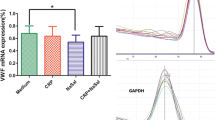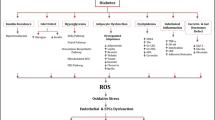Abstract
Emerging evidence demonstrates that high plasma C-reactive protein (CRP) levels or low plasma insulin-like growth factor 1 (IGF-1) concentrations may be separately associated with the increased risk of coronary artery disease or myocardial infarction. Interestingly, animal model studies and epidemiological investigations indicate that circulating IGF-1 and CRP levels have an inverse correlation. The present study aims to evaluate if IGF-1 can directly oppose the effects of CRP on endothelial cell (EC) activation. We found that IGF-1 rescues endothelial nitric oxide synthase activity and decreases the release of intercellular adhesion molecule-1 and vascular cell adhesion molecule-1 from ECs. We also showed that IGF-1 antagonizes the effects of CRP by activating the PI3K/Akt pathway and suppressing the JNK/c-Jun and MAPK p38/ATF2 signaling pathways, rather than inhibiting ERK1/2 activity. These findings provide evidence of the physiopathological mechanisms of endothelial activation and novel insights into the protective properties of IGF-1.






Similar content being viewed by others
References
Ferri C, Croce G, Cofini V, De Berardinis G, Grassi D, Casale R, Properzi G, Desideri G (2007) C-reactive protein: interaction with the vascular endothelium and possible role in human atherosclerosis. Curr Pharm Des 13:1631–1645
Koenig W (2005) Predicting risk and treatment benefit in atherosclerosis: the role of C-reactive protein. Int J Cardiol 98:199–206
Paffen E, DeMaat MP (2006) C-reactive protein in atherosclerosis: a causal factor? Cardiovasc Res 71:30–39
Zhong Y, Li SH, Liu SM, Szmitko PE, He XQ, Fedak PW, Verma S (2006) C-Reactive protein upregulates receptor for advanced glycation end products expression in human endothelial cells. Hypertension 48:504–511
Conti E, Carrozza C, Capoluongo E, Volpe M, Crea F, Zuppi C, Andreotti F (2004) Insulin-like growth factor-1 as a vascular protective factor. Circulation 110:2260–2265
Conti E, Musumeci MB, De Giusti M, Dito E, Mastromarino V, Autore C, Volpe M (2011) IGF-1 and atherothrombosis: relevance to pathophysiology and therapy. Clin Sci (Lond) 120:377–402
Kaplan RC, Strickler HD, Rohan TE, Muzumdar R, Brown DL (2005) Insulin-like growth factors and coronary heart disease. Cardiol Rev 13:35–39
Juul A, Scheike T, Davidsen M, Gyllenborg J, Jorgensen T (2002) Low serum insulin-like growth factor I is associated with increased risk of ischemic heart disease: a population-based case-control study. Circulation 106:939–944
Tvarijonaviciute A, Eralp O, Kocaturk M, Yilmaz Z, Ceron JJ (2010) Adiponectin and IGF-1 are negative acute phase proteins in a dog model of acute endotoxaemia. Vet Immunol Immunopathol 140:147–151
Pardina E, Ferrer R, Baena-Fustegueras JA, Lecube A, Fort JM, Vargas V, Catalan R, Peinado-Onsurbe J (2010) The relationships between IGF-1 and CRP, NO, leptin, and adiponectin during weight loss in the morbidly obese. Obes Surg 20:623–632
Colangelo LA, Chiu B, Kopp P, Liu K, Gapstur SM (2009) Serum IGF-I and C-reactive protein in healthy black and white young men: the CARDIA male hormone study. Growth Horm IGF Res 19:420–425
Lawlor DA, Ebrahim S, Smith GD, Cherry L, Watt P, Sattar N (2008) The association of insulin-like-growth factor 1 (IGF-1) with incident coronary heart disease in women: findings from the prospective British women’s heart and health study. Atherosclerosis 201:198–204
Efstratiadis G, Tsiaousis G, Athyros VG, Karagianni D, Pavlitou-Tsiontsi A, Giannakou-Darda A, Manes C (2006) Total serum insulin-like growth factor-1 and C-reactive protein in metabolic syndrome with or without diabetes. Angiology 57:303–311
Lee SD, Huang CY, Shu WT, Chen TH, Lin JA, Hsu HH, Lin CS, Liu CJ, Kuo WW, Chen LM (2006) Pro-inflammatory states and IGF-I level in ischemic heart disease with low or high serum iron. Clin Chim Acta 370:50–56
Wallander M, Brismar K, Ohrvik J, Ryden L, Norhammar A (2006) Insulin-like growth factor I: a predictor of long-term glucose abnormalities in patients with acute myocardial infarction. Diabetologia 49:2247–2255
Deepak D, Daousi C, Javadpour M, Clark D, Perry Y, Pinkney J, Macfarlane IA (2010) The influence of growth hormone replacement on peripheral inflammatory and cardiovascular risk markers in adults with severe growth hormone deficiency. Growth Horm IGF Res 20:220–225
Franco C, Andersson B, Lonn L, Bengtsson BA, Svensson J, Johannsson G (2007) Growth hormone reduces inflammation in postmenopausal women with abdominal obesity: a 12-month, randomized, placebo-controlled trial. J Clin Endocrinol Metab 92:2644–2647
McCallum RW, Sainsbury CA, Spiers A, Dominiczak AF, Petrie JR, Sattar N, Connell JM (2005) Growth hormone replacement reduces C-reactive protein and large-artery stiffness but does not alter endothelial function in patients with adult growth hormone deficiency. Clin Endocrinol (Oxf) 62:473–479
Ma S, Liu S, Huang Q, Xie B, Lai B, Wang C, Song B, Li M (2012) Site-specific phosphorylation protects glycogen synthase kinase-3beta from calpain-mediated truncation of its N and C termini. J Biol Chem 287:22521–22532
Venugopal SK, Devaraj S, Yuhanna I, Shaul P, Jialal I (2002) Demonstration that C-reactive protein decreases eNOS expression and bioactivity in human aortic endothelial cells. Circulation 106:1439–1441
Pasceri V, Willerson JT, Yeh ET (2000) Direct proinflammatory effect of C-reactive protein on human endothelial cells. Circulation 102:2165–2168
Qamirani E, Ren Y, Kuo L, Hein TW (2005) C-reactive protein inhibits endothelium-dependent NO-mediated dilation in coronary arterioles by activating p38 kinase and NAD(P)H oxidase. Arterioscler Thromb Vasc Biol 25:995–1001
Xu JW, Morita I, Ikeda K, Miki T, Yamori Y (2007) C-reactive protein suppresses insulin signaling in endothelial cells: role of spleen tyrosine kinase. Mol Endocrinol 21:564–573
Kawanami D, Maemura K, Takeda N, Harada T, Nojiri T, Saito T, Manabe I, Imai Y, Nagai R (2006) C-reactive protein induces VCAM-1 gene expression through NF-kappaB activation in vascular endothelial cells. Atherosclerosis 185:39–46
Liang YJ, Shyu KG, Wang BW, Lai LP (2006) C-reactive protein activates the nuclear factor-kappaB pathway and induces vascular cell adhesion molecule-1 expression through CD32 in human umbilical vein endothelial cells and aortic endothelial cells. J Mol Cell Cardiol 40:412–420
Anand SS, Yusuf S (2010) C-reactive protein is a bystander of cardiovascular disease. Eur Heart J 31:2092–2096
Bisoendial RJ, Boekholdt SM, Vergeer M, Stroes ES, Kastelein JJ (2010) C-reactive protein is a mediator of cardiovascular disease. Eur Heart J 31:2087–2091
Schunkert H, Samani NJ (2008) Elevated C-reactive protein in atherosclerosis–chicken or egg? N Engl J Med 359:1953–1955
Zacho J, Tybjaerg-Hansen A, Jensen JS, Grande P, Sillesen H, Nordestgaard BG (2008) Genetically elevated C-reactive protein and ischemic vascular disease. N Engl J Med 359:1897–1908
Turu MM, Slevin M, Matou S, West D, Rodriguez C, Luque A, Grau-Olivares M, Badimon L, Martinez-Gonzalez J, Krupinski J (2008) C-reactive protein exerts angiogenic effects on vascular endothelial cells and modulates associated signalling pathways and gene expression. BMC Cell Biol 9:47
Chen Y, Wang J, Yao Y, Yuan W, Kong M, Lin Y, Geng D, Nie R (2009) CRP regulates the expression and activity of tissue factor as well as tissue factor pathway inhibitor via NF-kappaB and ERK 1/2 MAPK pathway. FEBS Lett 583:2811–2818
Wallez Y, Huber P (2008) Endothelial adherens and tight junctions in vascular homeostasis, inflammation and angiogenesis. Biochim Biophys Acta 1778:794–809
Escudero-Esparza A, Jiang WG, Martin TA (2012) Claudin-5 participates in the regulation of endothelial cell motility. Mol Cell Biochem 362:71–85
Tai LM, Holloway KA, Male DK, Loughlin AJ, Romero IA (2010) Amyloid-beta-induced occludin down-regulation and increased permeability in human brain endothelial cells is mediated by MAPK activation. J Cell Mol Med 14:1101–1112
Ramirez SH, Fan S, Dykstra H, Rom S, Mercer A, Reichenbach NL, Gofman L, Persidsky Y (2013) Inhibition of glycogen synthase kinase 3β promotes tight junction stability in brain endothelial cells by half-life extension of occludin and claudin-5. PLoS ONE 8:e55972
Vandenbroucke E, Mehta D, Minshall R, Malik AB (2008) Regulation of endothelial junctional permeability. Ann N Y Acad Sci 1123:134–145
Higashi Y, Sukhanov S, Anwar A, Shai SY, Delafontaine P (2010) IGF-1, oxidative stress and atheroprotection. Trends Endocrinol Metab 21:245–254
Acknowledgments
This study was supported by the National Natural Science Foundation of China (No. 81300151), Research Fund for the Doctoral Program of Higher Education of China (No. 20124423120001), Research Project for Post-doctoral Program of Guangzhou city (No.310109-002), Research Fund for the Doctoral Program of Guangzhou Medical University (No.52010202), and Foundation for Distinguished Young Talents in Higher Education of Guangdong, China (No. 2012LYM_0111).
Author information
Authors and Affiliations
Corresponding author
Rights and permissions
About this article
Cite this article
Liu, SJ., Zhong, Y., You, XY. et al. Insulin-like growth factor 1 opposes the effects of C-reactive protein on endothelial cell activation. Mol Cell Biochem 385, 199–205 (2014). https://doi.org/10.1007/s11010-013-1828-y
Received:
Accepted:
Published:
Issue Date:
DOI: https://doi.org/10.1007/s11010-013-1828-y




